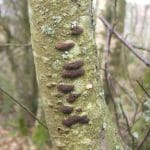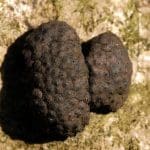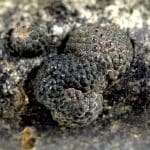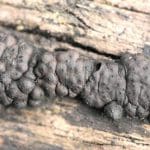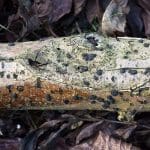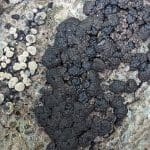Birch Woodwart / Spring / Summer / Autumn / Winter / Inedible
The Birch Woodwart (Jackrogersella multiformis) is.found predominantly on dead or decaying birch trees, this fungus is notable for its dark, warty fruiting bodies that can vary in shape and size.
Often mistaken for lumps of coal or charred wood, the Birch Woodwart has a unique appearance that makes it a fascinating subject for study and observation.
In this blog post, we’ll delve into the key identifying features of Birch Woodwart, explore its ecological role in forest ecosystems, and provide tips for locating and identifying this unusual fungus in the wild.
Scientific Name
Jackrogersella multiformis
Common Names
Birch Woodwart
Family
Polyporaceae
Habitat
They are saprotrophic and they can appear all year round on dead trunks and branches of Birch mostly, but they can be found on dead wood of other deciduous trees
They are widespread and common.
Description
A common species and easy to identify fungus but unfortunately too tough to be classed as edible.
Identifying Features:
The fungus produces irregular hard, black warty growths. They vary in shape from round to elongated and generally grow out of fissures in the bark.
When very young they are a rusty-red colour. They then turn brown-black or black and are dotted with raised pores.
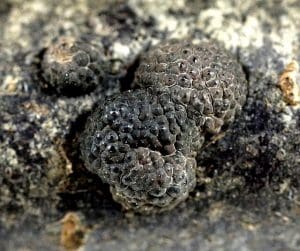
Smell:
No distinct smell.
Spores:
Dark brown.
Uses of:
Not thought to be toxic but inedible due to their tough texture.
Known hazards
No known hazards.
Potential lookalikes
They could be confused the Beechwood Woodwart (Jackrogersella cohaerens), as it looks almost identical, but as the name suggest these grow exclusively on beech trees.
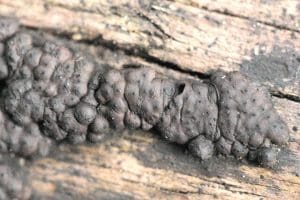
The Birch Woodwart (Jackrogersella multiformis) can be mistaken for several other fungi due to its unique, dark, warty appearance.
Here are some other common look-alikes and the key differences to help in accurate identification:
- King Alfred’s Cakes (Daldinia concentrica)
- Appearance: Hard, black, and rounded fruiting bodies that resemble lumps of coal.
- Key Differences: When sliced open, King Alfred’s Cakes reveal concentric rings inside, similar to tree rings. Birch Woodwart does not have these concentric rings and often has a more irregular shape.
- Carbon Balls (Kretzschmaria deusta)
- Appearance: Black, crusty, and irregularly shaped fruiting bodies, often found on the base of trees or stumps.
- Key Differences: Carbon Balls are more likely to be found at the base of living trees and have a crusty surface that can sometimes turn greyish or whitish with age. Birch Woodwart typically grows on dead or decaying birch wood and retains a more consistently dark and warty texture.
- Black Knot (Apiosporina morbosa)
- Appearance: Black, swollen, and knobby galls found on branches and twigs, primarily of cherry and plum trees.
- Key Differences: Black Knot causes distinct galls on living branches and twigs of cherry and plum trees, whereas Birch Woodwart is found on dead or decaying birch wood. Additionally, Black Knot galls are often elongated and more cylindrical compared to the more irregularly shaped Birch Woodwart.
- Hypoxylon fungi (Hypoxylon spp.)
- Appearance: Dark, cushion-like stromata that can be black, brown, or grey.
- Key Differences: Hypoxylon species have a smoother, more cushion-like appearance compared to the warty texture of Birch Woodwart. They also tend to form flatter fruiting bodies and can be found on various hardwoods, not just birch.
Extra notes
They have recently been re-categorised and moved to the Jackrogersella genus which only contains 6 species worldwide.
References:
https://species.nbnatlas.org/species/NHMSYS0020467970
https://fungi.myspecies.info/all-fungi/jackrogersella-multiformis



